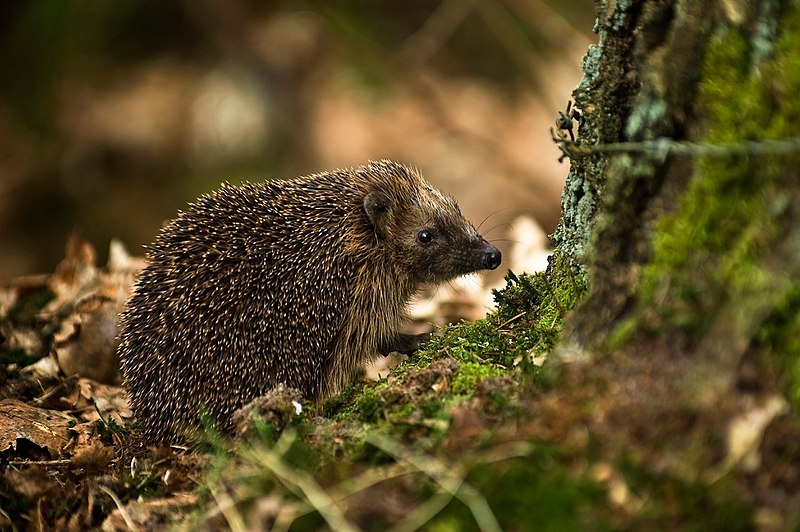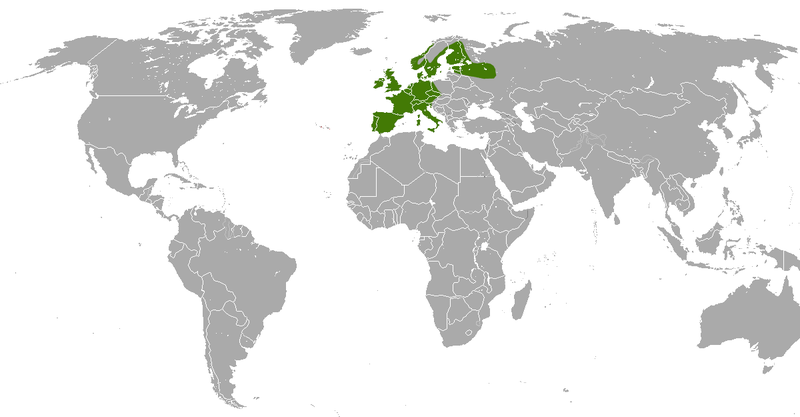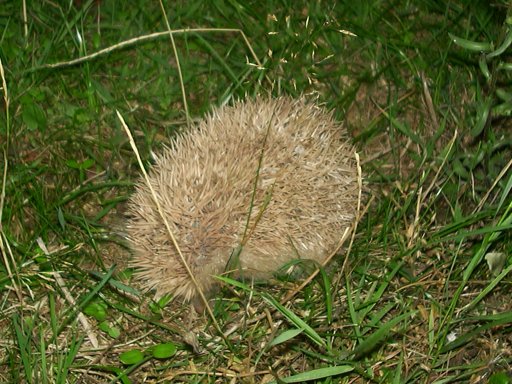| European Hedgehog[1] | |
|---|---|
 | |
| Conservation status | |
 Least Concern (IUCN 3.1)[2] | |
| Scientific classification | |
| Kingdom: | Animalia |
| Phylum: | Chordata |
| Class: | Mammalia |
| Order: | Erinaceomorpha |
| Family: | Erinaceidae |
| Subfamily: | Erinaceinae |
| Genus: | Erinaceus |
| Species: | E. europaeus |
| Binomial name | |
| Erinaceus europaeus Linnaeus, 1758 | |
 | |
| European Hedgehog whole range | |
 | |
| European Hedgehog native range | |
The European Hedgehog (Erinaceus europaeus), Common hedgehog or just Hedgehog in the anglophoneparts of Europe, is a hedgehog species found in northern and western Europe. It is about 20 to 30 cm in length. Adult mass typically ranges from 600 (after hibernation) to up to 1,200 g (prior to hibernation); occasionally, it may reach as much as 1,600 g. Males tend to be slightly longer and heavier than females.
The European Hedgehog lives in woodland, farmland and suburban areas. It is nocturnal, and if alarmed will roll itself into a ball, protecting itself against potential predators with its spines.
Unlike the smaller, warmer climate species, the European Hedgehog may hibernate in the winter. It is omnivorous, feeding on a wide range of invertebrates, but preferring slugs, earthworms, beetles and other insects. The preferred arthropods are the millipedes Glomeris marginata and Tachypodoiulus niger as well as the ground beetle Carabus nemoralis.[3] It is also known to eat frogs, small rodents, young birds and birds' eggs.
 |
Blonde hedgehog |
Blonde hedgehogs have a rare recessive gene giving rise to beady, button-black eyes and creamy-coloured spines; they are not strictly speaking albino. They are extremely rare except on the Channel Islandof Alderney. A population of around a thousand is believed to exist. They allegedly carry no fleas, and are a localised island variant ofErinaceus europaeus.This species has become a serious pest in the Western Isles ofScotland, where introduced hedgehogs eat the eggs of ground-nesting waders such as Common Snipe, Dunlin, Common Redshank andNorthern Lapwing. It is also considered a pest in New Zealand where it preys upon the native giant snails (Powelliphanta), weta, and various other native invertebrates.[4]
A low coverage assembly of the genome of Erinaceus europaeus was released by the Broad Institute in June 2006 as part of the Mammalian Genome Project.[5]
[edit]Protection list
On 28 August 2007, the new Biodiversity Action Plan (BAP) [launched in 1997] included the European Hedgehog on the list of species and habitats in the UK that need conservation and greater protection.[6][7]
In Denmark, hedgehogs are protected by law.[8] It is illegal to capture or hurt them, but it is accepted to house underweight hedgehogs found out during winter. Garden owners are encouraged to attract hedgehogs with a bit of dry cat food, to utilize their pest control abilities.
No comments:
Post a Comment